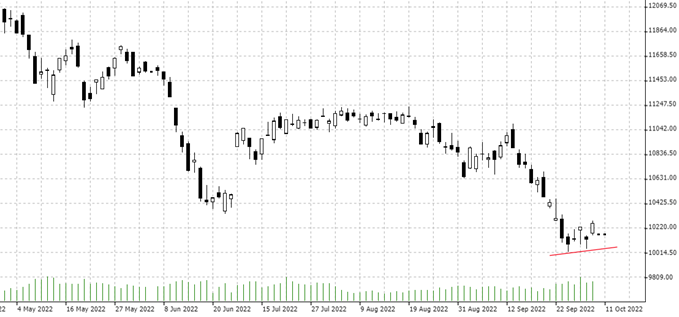

13.10.2022 – It smells like a crash: The Federal Reserve has provided the Swiss National Bank with a short-term credit line. And to the European Central Bank at the same time. At the same time, the major Swiss bank Credit Suisse can’t get out of the headlines because of its problems. Is there a connection here?
The crisis signals in the financial system are piling up. First, the Japanese National Bank had to intervene to support the dollar. Then the British pound got into turmoil. These are not over yet: just now, Andrew Bailey, the governor of the Bank of England, tightened the situation. He announced that the purchase of British government bonds to prop up domestic pension funds would end this Friday. World stock markets reacted with dismay. It looks like the U.S. junk bond market is now sliding as well – collateralized loan obligations are selling off.
3.1 billion dollars from the Fed
And now a new crisis signal from Switzerland. According to the financial blog ZeroHedge, the Federal Reserve has transferred $3.1 billion to the Swiss National Bank to cover a dollar supply emergency. This is the first time the Fed has sent greenbacks to the SNB this year, it said. The maturity is scheduled for Oct. 13, and the interest rate is 3.33 percent. See here: Central Bank Liquidity Swap Operations – FEDERAL RESERVE BANK OF NEW YORK (newyorkfed.org) The blog asked whether a “funding panic” was imminent. That is, someone desperately needs money and no one is lending any. So the central bank has to step in as lender of last resort. The question is whether the Swiss stock market – the picture shows the daily chart of the SMI 20 – will just shrug it off. In any case, short-term support had better hold.

Source: Bernstein Bank GmbH
The more important question is whether and who is left high and dry. In the 2008 financial crisis, the shares of Lehman Brothers and Bear Stearns were signaling that something was violently out of control. Credit Suisse may have just taken on that role. Indeed, the bank has demanded a lot from its investors in recent weeks. Since the beginning of this year, Switzerland’s second-largest financial house has lost around half of its stock market value. The bank closed the first half of the year with a loss of 1.9 billion francs. For the full year, the rating agency Moody’s expects a minus of three billion dollars. Credit Suisse has announced a “comprehensive strategy review,” with the results to be presented on October 27.
Problems at Credit Suisse
Two hedge fund bankruptcies cost about six billion euros. A data leak exposed criminal dealings with war criminals, gangsters and autocrats. In addition, CS currently has to pay more money for so-called credit default swaps. This is how banks protect themselves against loans that are not repaid: If the debtor goes bankrupt, the insurance takes over. According to media reports, credit default swaps are three to four times more expensive at CS than at its competitors. CS also faces losses from discontinued business in and with Russia. In addition, the exit from the risky investment business will be expensive for years.
Feast for Shorties
Andreas Venditti, an analyst at Bank Vontobel, said in an interview with the “Frankfurter Allgemeine Zeitung” that the share price could continue to go wildly up and down for the time being, especially since short sellers apparently also have their fingers in the pie. Only when it is clear exactly what the – presumably very costly – corporate restructuring will look like and how it will be financed, can the value of the bank be determined.
Our conclusion: Perhaps CS will manage the turnaround and we will experience a short squeeze. Perhaps the Fed’s loan to the SNB should not be overestimated either. Possibly the money is not for Credit Suisse at all. But the bank definitely has some problems to deal with – and it is indeed systemically important for the Swiss financial center. In any case, there is a string of news that is making some investors extremely nervous, because it is reminiscent of the crash of 2008. Bernstein Bank advises increased vigilance – perhaps you should use part of your portfolio for Protective Puts.
The content of this publication is for general information purposes only. In this context, it is neither an individual investment recommendation or advice nor an offer to purchase or sell securities or other financial products. The content in question and all the information contained therein do not in any way replace individual investor- or investment-oriented advice. No reliable forecast or indication for the future is possible with respect to any presentation or information on the present or past performance of the relevant underlying assets. All information and data presented in this publication are based on reliable sources. However, Bernstein Bank does not guarantee that the information and data contained in this publication is up-to-date, correct and complete. Securities traded on the financial markets are subject to price fluctuations. A contract for difference (CFD) is also a financial instrument with leverage effect. Against this backdrop, CFD trading involves a high risk up to the point of total loss and may not be suitable for all investors. Therefore, make sure that you have fully understood all the correlating risks. If necessary, ask for independent advice. CFDs are complex instruments and are associated with the high risk of losing money quickly because of the leverage effect. 68% of retail investor accounts lose money trading CFD with this provider. You should consider whether you understand how CFD work and whether you can afford to take the high risk of losing your money.7
